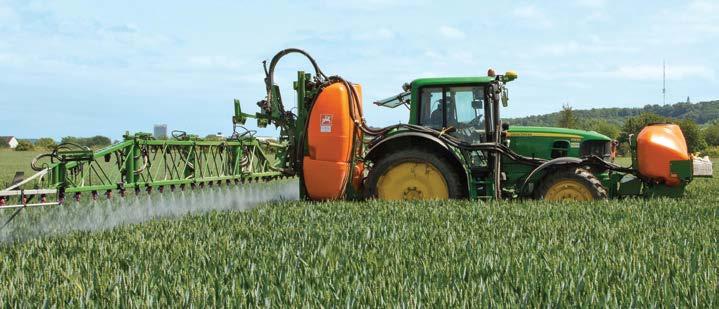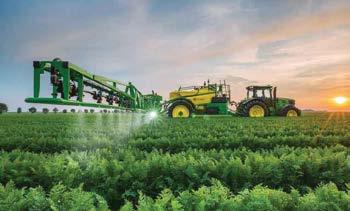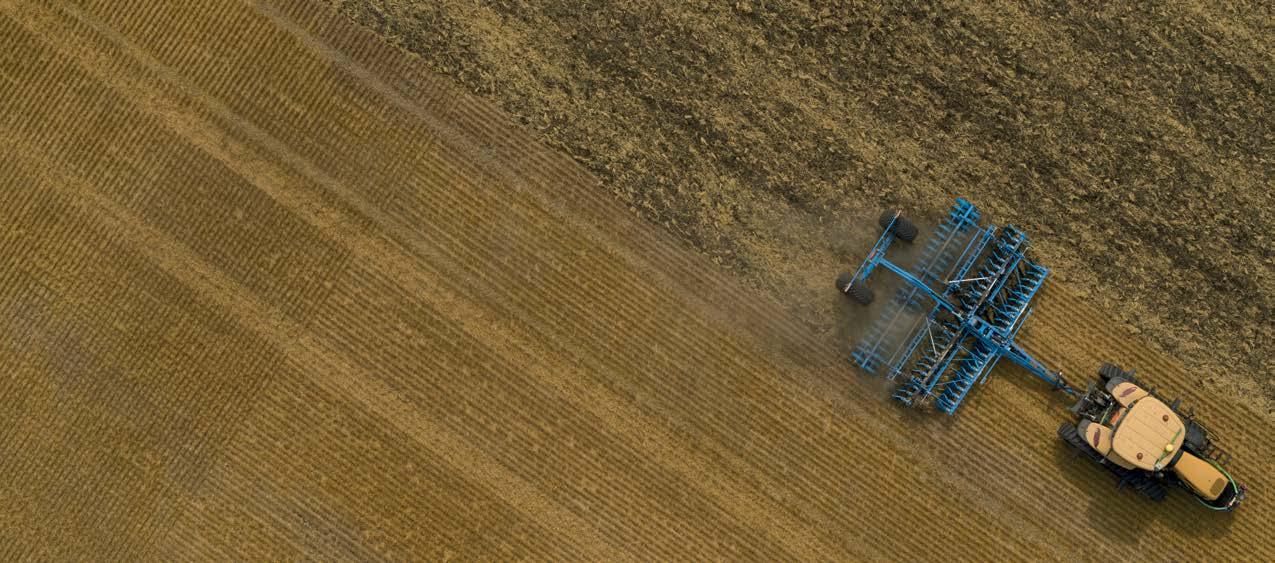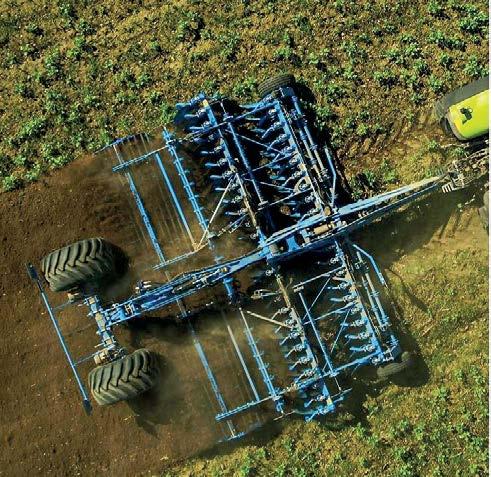
5 minute read
Protect your crop Part 3: Choose between trailed, hitch or self-propelled sprayers
from ProAgri BNZ 15
by ProAgri
Protect your crop 3: Choose between trailed, hitch or self-propelled sprayers
In the previous issue we discussed different spray nozzles and the importance of making the right choice. Another choice must be made between models being drawn by a tractor, models carried on the hitch and self-propelled sprayers, but first some more information on the interesting method of using air-supported boom sprayers.
Advertisement
Air supported boom sprayers
Air-supported boom sprayers appeared in South Africa in the nineties, although the principle had already been launched abroad earlier.
The principle of operation
The tractor drives a fan, and the airstream is blown into a strong PVC bag or stocking. This airstream is then forced out through a series of holes at the bottom of the bag. Air speed at the outlets is approximately 50 m/second. The air volume and air speed are the same at each outlet across the length of the bag. The spray boom is mounted under the bag. The spray nozzles on the boom are placed 250 mm apart and are mounted at an angle of 30° to the vertical airstream. The airstream pushes the spray droplets to the plants or the soil. The air movement also ensures that the spray reaches the bottoms of the leaves efficiently. The outstanding features of the spray are that, instead of high volumes of water (250 litres/ha and more) and large droplets such as in conventional boom sprayers, the air supported boom sprayer uses lower volumes (30 to 75 litres/ha) and smaller droplets being pushed by a strong vertical air stream towards the soil. Some of the farmers who purchased the sprayers are satisfied that they apply herbicides and pesticides very effectively. They particularly emphasised the following beneficial properties of the sprayers and the spraying principles:
Less water
At 30 to 75 litres of water per hectare commonly used by air supported boom sprayers, the cost and effort to transport clean water to the fields are immediately alleviated. Comparing the water needs of an air supported boom sprayer and a conventional sprayer for 500 hectares, the results are: Air supported sprayer (75 ℓ/ha) = 37 500 litres for 500 hectares Conventional sprayer (250 ℓ/ha) = 125 000 litres for 500 hectares

The savings in the quantity of water to be supplied in the field are therefore obvious, especially where water needs to be transported over long distances to fields.


Self-propelled sprayer.

Reduction of drift
When spraying in windy conditions, the downwardly directed air stream of air supported boom sprayers ensures that less spray will drift and be lost due to the prevailing wind. This improves spray efficiency.
Hydraulically controlled boom
The sprayer’s well designed, hydraulically controlled spray boom makes the handling of the sprayer easier.
What does it cost to spray?
It is important to determine what the mechanisation cost of a spray programme is above and beyond the cost of the spraying itself. Factors determining the mechanisation cost are the purchase cost of the spray tractor and the sprayer, the speed at which the sprayer works, and the width of the spray. In this regard, the Mechanisation Guide of JP le Roux is very handy to read the cost per hectare or per hour. In table 1 the cost for different sprayers is linked to four-wheel drive tractors from 60 to 65 kW. The guide gives all the information on spray costs with tractors from 30 to 90 kW and a series of sprayers. More and more self-propelled sprayers are seen on farms, and these sprayers can cover large areas per day, because they also work at a higher speed. A further benefit is that the technology with which they are equipped makes the calibration process much easier. The cost of these sprayers is shown in Table 2. With the sprayer properly checked, the correct nozzles selected, the correct spray applied as prescribe on the label, the sprayer correctly calibrated,
Trailed sprayer.
and also with knowledge of the cost of spraying per hectare, you are ready to start spraying.
Table 2 Cost of self-propelled sprayers.
Self-propelled sprayers with engines from 100 to 150 kW
Boom width Speed km/hour Cost R/hour 24 m 9 2 546,78 24 m 12 2 713,14 24 m 15 2 767,40
Self-propelled sprayers with engines from 150 to 210 kW
Boom width Speed km/hour Cost R/hour 30 m 9 3 764,03 30 m 12 3 792,59 30 m 15 3 621,15
Self-propelled sprayers with engines from 210 to 260 kW
Boom width Speed km/hour Cost R/hour 36 m 9 4 074,90 36 m 12 4 146,30 36 m 15 4 203,42 Cost R/ ha 157,21 125,51 102,50
Cost R/ ha 185,88 140,47 113,22
Cost R/ ha 167,69 127,67 103,79
Table 1 Spraying costs for tractor sprayers
Tractor 60 – 65 kW 4WD Type of sprayer Working width 400/600 ℓ 3pt 3,6 m 800 ℓ 3pt 7,2 m 800 ℓ 3pt 12 m Speed Km/hour 8,5 8,5 8,5
2 800 ℓ trailed 2 000 ℓ air supported booM 12 m 16 m 8,5 8,5 Cost R/hour
314,70 331,69 331,69
1 397,51 1 031,85 Cost R/ha
158,22 83,38 50,03
210,79 116,72
To summarise
A good sprayer is paramount in a successful crop production operation. Where farmers are increasingly switching to no-till operations, a good sprayer is indispensable for success.
With thanks to JP le Roux, compiler of the Mechanisation Guide.
The Mechanisation Guide can be ordered from Koos le Roux at +27 82-828-9531 or koosleroux@ live.co.za.
RUBIN 10
HIGH EFFICIENCY. HIGH ACREAGE. HIGH YIELDS.



RUBIN 10 - its superior clearance and 25”discs allow the Rubin 10 to work and control a greater amount of organic matter. Its symmetrical arrangement of discs is unique in the industry and ensures work in a straight line without any lateral offset. Working in a straight line saves fuel and optimizes GPS guidance.

Hydraulic depth control adjustable from the tractor cab. Unique symmetrical disc arrangement for optimized GPS and fuel economy. Individually mounted and guided discs with non-stop spring-loaded safety device for high speed work.
Contact your nearest dealer to find out more about LEMKEN
Karel Munnik, director, 082 412 2577, k.munnik@lemken.com Blackie Swart, area sales manager, 082 404 9651, b.swart@lemken.com

RAINMAKER THE www.reinke.com

Patrick Ellis
+27 (0)31 350 4525 patrickellis@reinke.com










